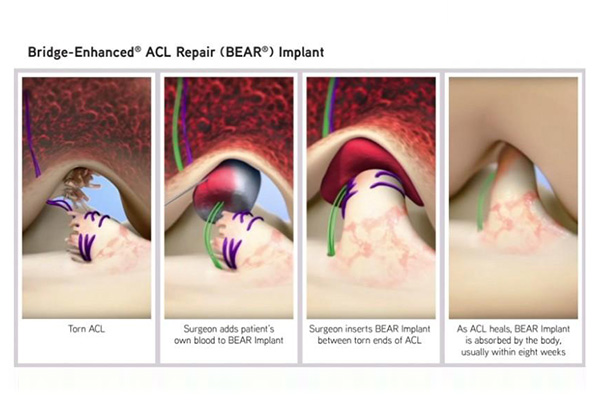
BEAR Implant - Bridge Enhanced ACL Restoration
Approximately 100,000 to 200,000 individuals sustain ACL tears every year in the US. Unlike most ligament sprains, ACL injuries do not heal independently, especially if the ACL is completely torn. Traditionally, an ACL reconstruction is performed to enable full recovery of knee stability.
A new, FDA approved, innovative procedure that orthopedic specialists can now perform to treat ACL tears, and that's the Bridge Enhanced ACL Restoration or BEAR Implant.
What Is the BEAR Technique?
The Bridge Enhanced ACL Restoration (BEAR) technique refers to a procedure used to treat ruptured or torn ACLs. This new, FDA-approved procedure serves as a much better alternative than traditional ACL reconstruction for its less invasive and less complex nature.
The BEAR technique works by using a medical device called BEAR Implant to bridge the gap between the torn ACL ends. The implant is a bovine-derived extracellular matrix that will help repair the ruptured ACL without requiring tissue grafts.
This procedure helps restore the native ACL through the combined method of suture repair and BEAR technique. Unlike the traditional ACL reparation, there's no need for donor tissues or autograft to completely treat one's ACL injury.
The BEAR Technique and the Treatment of ACL Injuries
The anterior cruciate ligament (ACL) is a band of thick connective tissue that runs from the femur to the tibia. Its primary function is to stabilize the knee joint by securing the tibia to the femur, thus preventing tibial translation. Additionally, the ACL band also allows the knees' rotational movement and back and forth motion.
The goal of the Bridge Enhanced ACL Restoration technique is to offer an alternative to ACL Reconstruction in a less invasive manner.
More Information:
- This technique uses an FDA-approved bridging device called BEAR implant to treat the torn ACL.
- >A small incision will be made so your surgeon can place the implant using arthroscopic materials. It will be situated in the space between the two ACL ends.
- Then, autologous (patient's) blood will be added to the BEAR implant to activate clot formation. This will, later on, serve as the bridging structure that will support cellular migration and proliferation.
- Finally, the BEAR implant is secured by stitching the torn ACL ends onto it.
Within eight weeks of implantation, the BEAR device will be absorbed by the body and replaced by new native cells and tissues that will eventually become the new ligaments.
Although newly approved, this procedure has been a groundbreaking addition to the medical industry.
What is the Difference Between BEAR and ACL Reconstruction?
Traditionally, rebuilding the ligaments involves replacing the torn ACL bands with a tissue graft. Once the damaged ligaments are removed, the orthopedic specialist will drill the tissue graft (from a donor or your own tendon) into the bones to facilitate the regrowth of new ligaments in the area.
Although effective, traditional ACL reconstruction can have several adverse effects due to its complex procedure. Some of its known risks include the following:
- Failed reconstruction due to tissue rejection during an allograft or tissue from a donor.
- Compromising the health of other healthy tissues to facilitate autograft. For example, studies have found that the hamstring losses 10 to 50% of its strength after a hamstring autograft.
- Higher incidence of developing post-traumatic osteoarthritis or knee degeneration.
On the other hand, the Bridge Enhanced ACL Restoration does not have these consequences since there's no tissue grafting involved. Instead, it utilizes an implant mixed with the patient's blood to facilitate healing while maintaining the ACL's original attachments to the knee joints.
Furthermore, the BEAR implant is an easy and reproducible procedure that can be used for different types of ACL tears.
Indications for BEAR: https://www.fda.gov/news-events/press-announcements/fda-authorizes-marketing-new-implant-repair-torn-acl
The BEAR Implant is indicated for skeletally mature patients at least 14 years of age with a complete rupture of the ACL, as confirmed by MRI.
Patients must have an ACL stump attached to the tibia to construct the repair.
The BEAR device must be implanted within 50 days of injury.
To set up a consultation to understand if BEAR is right for you, Dr. Catherine Logan's team may be reached at 720-726-7995.


